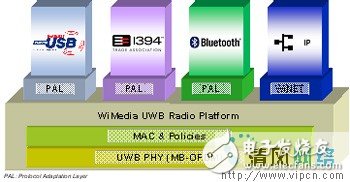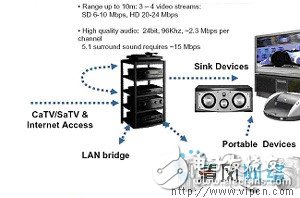Ultra-wideband communication (UWB) is a wireless interconnection technology that has emerged in the field of communication in recent years.
UWB has the characteristics of high data rate, low power consumption, simple structure and low price, which opens up new opportunities for the development of wireless communication. At the same time, because it occupies an extremely wide bandwidth and shares frequency bands with other communication systems, research on related fields such as interference and compatibility has also brought certain challenges.
First, UWB technology featuresUWB (UltraWideBand) is a technology that achieves a transmission rate of 100 Mbps to 1 Gbps over a large bandwidth. According to Shannon's theory, the capacity of a wireless channel is proportional to the channel bandwidth it occupies. UWB can achieve a very high data rate because it takes up a lot of bandwidth. According to the US FCC definition of UWB technology, a system with a relative bandwidth greater than 0.2 or a bandwidth exceeding 500 MHz can be regarded as a UWB system, and a band of 3.1-10.6 GHz is allocated as a frequency band usable by the UWB system, in which UWB devices are transmitted. The power needs to be lower than -41.3dBm/MHz for coexistence with other wireless communication systems. UWB implements wireless transmission within a range of 10 m or less, and is a short-range wireless communication technology applied to a wireless personal area network (WPAN).
As we all know, IEEE802.15.3a began to standardize UWB technical solutions in 2003. In the UWB physical layer technology implementation, there are two mainstream technical solutions: multi-band OFDM (MB-OFDM) scheme based on Orthogonal Frequency Division Multiplexing (OFDM) technology, and direct sequence CDMA (DS-CDMA) based on CDMA technology. Program. CDMA technology is widely used in 2G and 3G mobile communication systems. The CDMA technology used in UWB systems is not fundamentally different from the CDMA technology used in traditional communication systems, except that a very high chip rate is used to obtain UWB-compliant technology. Standard extra wide bandwidth. OFDM is a core technology applied to E3G and B3G, and has the advantages of high spectral efficiency, anti-multipath interference and strong anti-narrowband interference.
Direct Sequence Spread Spectrum Ultra Wideband Technology (DS-UWB) is primarily a solution supported by Freescale Semiconductor. The MB-OFDM scheme is supported by the WiMEDIa Alliance. Both standards have been in a heated debate for a long time. Evaluating DS-CDMA and MB-OFDM is technically superior and inferior, and the final compromise of the solution is not beneficial. Although there have been many votes in IEEE802.15.3a, it has not been possible to eliminate one of the standards and achieve uniformity. Finally, at the IEEE802 conference held in January 2006, 802.15.3a was voted to disband the task group, and the UWB standardization process in IEEE was terminated.
UWB's MAC layer protocol supports distributed network topology and resource management. It does not require a central controller, that is, supports Ad-hoc or mesh networking, supports synchronous and asynchronous services, supports low-cost device implementation, and supports multiple levels of power saving. mode. The protocol stipulates that the network is based on piconet, and the master device is called piconet coordinator (PNC). The PNC is responsible for providing synchronous clocking, QoS control, power saving mode, and access control. As an AdHoc network, piconet only exists when communication is required, communication ends, and the network disappears. Other devices in the network are slave devices. The data exchange of the WPAN network is directly performed between the WPAN devices, but the control information of the network is sent by the PNC.
Second, WiMEDIALike the well-known Wi-Fi and WiMAX alliances, the WiMedia Alliance's mission is to establish WPAN certification processes and specifications, to certify devices to ensure interoperability, and to promote UWB technology worldwide. The WiMedia Alliance is made up of well-known companies such as Intel, TI, Panasonic, Samsung, Nokia, Fujitsu and many consumer electronics companies. Since its establishment more than three years ago, it has a very wide membership.
The layering of the UWB protocol defined by the WiMedia Alliance is shown in Figure 1. It has been mentioned above that there are two branches of MB-OFDM and DS-UWB in the physical layer, and WiMedia currently mainly adopts MB-OFDM. To support multiple applications, such as wireless UWB, wireless IEEE 1394, etc., the WiMedia Alliance defines a Protocol Adaptation Layer (PAL) on top of the physical layer and the MAC layer.

Figure 1 Schematic diagram of UWB protocol layering
The WiMedia Alliance has released the physical layer certification specification and compatibility test platform, and has carried out several physical layer compatibility tests. The main UWB chips and equipment vendors have participated in the compatibility test. As the product matures, the WiMedia Alliance will officially launch UWB equipment certification.
Third, the development status and trend of UWB technologyThe application scenarios of UWB technology mainly include: home, office, and personal consumer electronics. Today, the concept of "digital home" or "digital home network" is becoming more and more popular. Consumer electronics companies paying attention to this concept are trying to connect the appliances in the consumer home with wireless networks, so that various large-bandwidth video information can be Transfer and exchange between these appliances, as shown in Figure 2.

Figure 2 Video information transmission and exchange diagram
The application in the digital office is to replace the traditional wired connection with wireless, which makes the office environment more convenient and flexible. Early Bluetooth technology has made wireless connectivity for some devices possible. However, because the transmission rate is too low (below 1 Mbps), it can only be used to connect certain computer peripherals (such as mouse, keyboard, earphone, etc.) to the host. The high transmission bandwidth of UWB technology enables wireless interconnection between the host and the display, camera, conference equipment, terminal equipment and projector. Similarly, UWB technology will also have scale applications on personal portable devices. Since UWB technology can provide a transmission rate equivalent to the computer bus, the personal terminal can instantly download a large amount of data from the Internet or a local area network, thereby storing most of the data in the storage space of the network server instead of being stored in the personal terminal. in. Carrying a small terminal with UWB function, you can access the local UWB network from any location, and use your local equipment (such as large-screen TV, computer, camera, printer, etc.) to form a multimedia computer of your own.
As can be seen from the above analysis, the replacement of the existing USB interface and 1394 interface cable connection, namely wireless UWB and wireless 1394 will become the most promising application of UWB technology. The Wireless USB Alliance has announced that the physical layer uses the MB-OFDM scheme, which will be a better driver for UWB applications.
In 2006, a number of companies have been able to provide UWB chips, such as Alereon, ArTImi, Staccato, Wisair, Intel, Infineon, etc., each with their own UWB chip solutions, including baseband chips, MAC chips, RF transceiver chips, or integration. Baseband, MAC and RF chips. At the same time, many chip companies announced that they will launch WiMedia-certified UWB chips in 2007 and will expand UWB applications in consumer electronics. Intel, which has an absolute leading position in the notebook chip market, is committed to UWB's main application, Wireless USB 2.0, as the standard configuration interface for notebook computers.
Fourth, problems in the development of UWB technologyAn important issue in UWB communication applications is the coexistence and compatibility issues with other communication systems. Since UWB systems use a very wide frequency band, they overlap with many other wireless communication system bands. Although theoretically speaking, the transmission power spectral density of UWB systems is very low, it should be able to “quietly coexist†with other systems. However, the compatibility of UWB systems with other systems in practical applications needs to be confirmed by experiments. There are still many unclear aspects of the working mechanism and characteristics of UWB systems, such as the out-of-band interference problem of UWB systems, that is, UWB devices may also cause certain interference to wireless systems outside their working frequency bands. Partial interference is also difficult to estimate accurately using theoretical calculations. Therefore, although the FCC sets the UWB operating band to be above 3.1 GHz, the interference of UWB devices to systems below 3.1 GHz (such as 2G/3G cellular mobile communication systems, PHS, and wireless LAN systems) also needs to be considered.
The FCC stipulates that the main operating frequency band of UWB equipment will be between 3.1 GHz and 10.6 GHz. In this frequency band, its transmission power is limited to below -41.3 dBm/MHz. Outside of this band, more stringent power control standards are implemented. In addition to considering interference with existing communication systems, it is also necessary to consider interference that may occur with existing non-communication services. In addition to the FCC, Japan also proposed its own UWB frequency range and transmit power control standard in 2006.
The ITU-RSG1 (Spectrum Planning Study Group) has established a 1/8 task group (TaskGroup 1/8) with a scope of study "compatibility between UWB devices and wireless communication services". During the research period of the task force, several principles for global UWB spectrum allocation and regulation were proposed.
On the day when the UWB concept was first proposed, the theoretical rate of the physical layer of WLAN is up to 54 Mb/s, and the effective rate is up to about 20 Mb/s, which is difficult to meet the needs of video signal transmission. However, as the physical layer can support the gradual advancement of the 802.11n standard above 100Mb/s, in 2006, many companies have introduced PRe-802.11n WLAN devices that support the physical layer rate of more than 100M. Compared to UWB, WLAN has several obvious technical advantages. WLAN works in the unlicensed band, with a high degree of standardization, and WLAN products are very mature. With the large-scale application of 802.11n in the next few years, the equipment cost will also drop to the level of existing 802.11g products. Therefore, in the future support for high-speed video streaming, such as wireless interconnection of devices in a home network, WLAN and UWB have a certain degree of application and positioning overlap. Of course, WLAN technology is developed to support wireless connectivity between PCs, so applications in the consumer electronics environment suffer from power and bandwidth limitations.
Although there are difficulties in frequency control and standardization in the development of UWB, it is also necessary to face competition from other wireless technologies. However, it is foreseeable that UWB will be acquired in the field of consumer electronics and communication as wireless multimedia applications become more and more popular. Large-scale application. Although there is no sign of integration in the physical layer plan, neither side has given up the pace of industrialization. Whoever will eventually occupy the market will become the de facto standard.
Flum Float,Flum Float 3000Puffs,Fruits Flavors Flum Float,Electronic Cigarettes Flum Float
Nanning Nuoxin Technology Co., LTD , https://www.nx-vapes.com